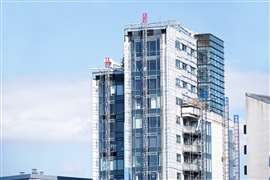UK government sets cladding removal deadline
18 July 2025
 High rise residential building of flats with cladding being replaced with fire resistant materials (Image: Richard Johnson via AdobeStock - stock.adobe.com)
High rise residential building of flats with cladding being replaced with fire resistant materials (Image: Richard Johnson via AdobeStock - stock.adobe.com)
UK government sets cladding removal deadlineThe UK government has set out plans for a new law that would set a deadline for building owners to fix unsafe cladding.
UK government sets cladding removal deadlineThe UK government has set out plans for a new law that would set a deadline for building owners to fix unsafe cladding.
The Remediation Bill is being brought forward “as soon as parliamentary timetable allows”.
Deputy Prime Minister Angela Rayner announced the move, which would give building owners two critical targets:
- By the end of 2029, all high‑rise (18 m and above) residential buildings covered by the government’s cladding‑remediation programmes must have unsafe cladding fully removed.
- By the same deadline, all buildings of 11–18 m in height must be fully remediated by 2031.
Those who fail to comply without a reasonable excuse could face unlimited fines or imprisonment.
New legislation would also give named bodies like Homes England and local authorities the power to remediate buildings with unsafe cladding if landlords failed to do so.
At the same time, Rayner announced that the government would invest over £1 billion to give social landlords equal access to government funding schemes as private building owners.
The Cladding Safety Scheme guidance has been updated so that the equal access policy can be implemented. As part of the work, housing associations, local authorities and regulators are committing to accelerate work to assess and fix social housing buildings.
More than 5,000 buildings over 11m in height have been identified as containing unsafe cladding in the UK, as part of an effort to remediate structures in the wake of the deadly Grenfell Tower fire in June 2017 that killed 72 people. Work has started on around half of those buildings, with work completed on just over 30%.


